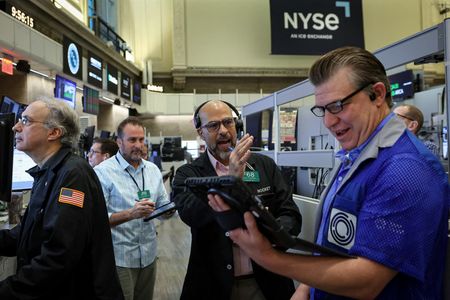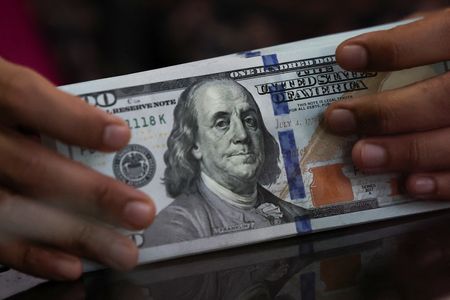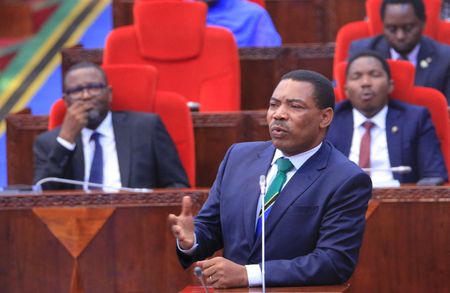By Sinéad Carew and Marc Jones
NEW YORK/LONDON (Reuters) -Wall Street indexes suffered their biggest one-day decline in a month on Thursday, pushing down MSCI’s global equities gauge while U.S. Treasury yields rose as investor bets for a December rate cut took a dive after hawkish comments by Federal Reserve officials.
In currencies, the dollar fell despite the prospects for slower rate cuts, in the first trading day after the House of Representatives voted late on Wednesday to reopen the U.S. government from its longest shutdown in history and President Donald Trump signed the bill.
Investors had been pouring into equities in recent sessions in anticipation of an end to the shutdown, which disrupted food benefits for millions, left hundreds of thousands of federal workers unpaid, and snarled air traffic while putting a pause on crucial economic data releases.
However, Trump administration officials dashed hopes for a clearer view of the U.S. economy any time soon. The White House indicated that the U.S. unemployment rate for October may never be available, since it is dependent on a household survey that was not conducted during the shutdown.
And pointing to worries about high inflation after two U.S. interest rate cuts this year, a growing number of Federal Reserve policymakers signaled caution about further rate cuts.
Alberto Musalem, who runs the St Louis Federal Reserve Bank, reiterated his view that there was limited room to ease further without becoming overly accommodative. Federal Reserve Bank of Cleveland President Beth Hammack said interest rate policy should remain restrictive in order to put downward pressure on still concerning levels of inflation.
Minneapolis Federal Reserve President Neel Kashkari said inflation was too high while parts of the labor market “look like they’re under pressure.” Earlier, San Francisco Federal Reserve President Mary Daly said the risks to the Fed’s two goals are now balanced after two rate cuts already this year.
Trader bets for a December rate cut were last showing a 51.9% probability, down from 62.9% on Wednesday, according to CME Group’s FedWatch tool.
“Markets were counting on a cut, and we may not get it,” said Bob Doll, chief executive and chief investment officer at Crossmark, pointing to cautious Fed comments on the prospects for a December easing of rates. “Most of them are putting up warning signs that it’s not a ‘gimme’, just like the Fed Chair told us when he did this presser after the last Fed meeting. In some sense, it’s not new, but people didn’t believe it.”
Anthony Saglimbene, chief market strategist at Ameriprise, said investors are looking at high valuations in heavyweight technology and artificial intelligence-linked stocks, adding to their worries about a continued lack of clarity around the U.S. economy. So, he said, it was not surprising to “see investors take a step back from risk, sell down the winners and go into the defensive areas of the market.”
EQUITIES MARK BIGGEST DROP IN A MONTH
On Wall Street, the technology-heavy Nasdaq Composite led losses, closing down 536.10 points, or 2.29%, at 22,870.36. The Dow Jones Industrial Average fell 797.60 points, or 1.65%, to 47,457.22, while the S&P 500 fell 113.43 points, or 1.66%, to 6,737.49. All three indexes registered their biggest daily declines since October 10.
MSCI’s gauge of stocks across the globe was down 12.07 points, or 1.19%, at 999.71, which would also be its biggest daily drop since October 10.
Earlier in the day, the pan-European STOXX 600 index closed down 0.61% while Europe’s broad FTSEurofirst 300 index finished off 0.66%. Both had hit record highs during their trading day.
In U.S. Treasuries, prices retreated, driving yields higher, as investors scaled back expectations for imminent rate cuts amid lingering uncertainty over the inflation outlook and stark divisions among Fed policymakers on the trajectory of the U.S. economy and monetary policy.
The yield on benchmark U.S. 10-year notes rose 4.4 basis points to 4.123%, from 4.079% late on Wednesday while the 30-year bond yield rose 5.4 basis points to 4.7162%. The 2-year note yield, which typically moves in step with interest rate expectations for the Federal Reserve, rose 3.1 basis points to 3.597%.
DOLLAR FALLS AGAINST EURO, YEN
In currencies, the U.S. dollar dipped as the government reopened, leaving traders grappling with the long-term impact of the shutdown on trust in the U.S. currency while investors waited for data on the health of the economy.
Meanwhile, European financial stability officials were debating whether to create an alternative to Federal Reserve funding backstops by pooling dollars held by non-U.S. central banks, aiming to reduce their reliance on the U.S. under the Trump administration, five officials familiar with the matter told Reuters.
“The shutdown is over, but how soon are we going to go back to normal? How soon are we going to have numbers? How soon am I going to be able to do real, accurate analysis based on trusted American statistics from September and October? That’s in doubt,” said Juan Perez, director of trading at Monex USA in Washington.
The dollar index, which measures the greenback against a basket of currencies including the yen and the euro, fell 0.29% to 99.19, with the euro up 0.34% at $1.1631. Against the Japanese yen, the dollar weakened 0.12% to154.58.
In cryptocurrencies, bitcoin was down 3.24% at $98,578.10, after falling to its lowest level since May.
In energy markets, oil futures settled slightly higher after selling off sharply in the previous session, as investors weighed concerns about global oversupply against looming sanctions against Russia’s Lukoil.
U.S. crude settled up 0.34%, or 20 cents, at $58.69 a barrel while Brent settled at $63.01 per barrel, up 0.48%, or 30 cents, on the day.
Gold prices pulled back after hitting a three-week high earlier in the session, amid the broad market selloff that followed the reopening of the U.S. government.
Spot gold fell 0.51% to $4,177.21 an ounce. U.S. gold futures fell 0.96% to $4,164.10 an ounce.
(Reporting by Sinéad Carew in New York, and Marc Jones and Stephanie Kelly in London; Additional reporting by Karen Brettell; Editing by Sharon Singleton, Ed Osmond and Edmund Klamann)











